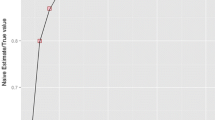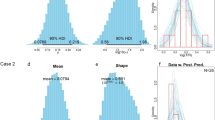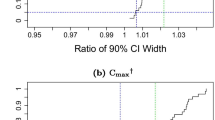Abstract
Purpose. i) To develop novel approaches for the construction of bioequivalence (BE) limits incorporating both the intrasubject variability and the geometric mean ratio (GMR), and ii) to assess the performance of the novel approaches in comparison to several scaled BE procedures and the classic unscaled average BE.
Methods. Plots of the BE limits or the extreme GMR values accepted as a function of the coefficient of variation (CV) were constructed for published and the developed scaled procedures. Two-period crossover BE investigations with 12, 24, or 36 subjects were simulated with assumptions of a CV 10%, 20%, 30%, or 40%. The decline in the percentage of accepted studies was recorded as the true GMR for the two formulations was raised from 1.00 to 1.50. Acceptance of BE was evaluated by published and the developed scaled procedures, and, for comparison, by the unscaled average BE.
Results. Two GMR-dependent BE limits are proposed for the evaluation of average BE: i) BELscG1 with Ln(Upper, Lower BE limit) = ±[(5 − 4GMR)0.496s + Ln(1.25)], and ii) BELscG2 with Ln(Upper, Lower BE limit) = ±[(3 - 2GMR)(0.496s + Ln(1.25))], where s is the square root of the intrasubject variance. The range of BE limits becomes narrower as GMR values deviate from unity, and increases with variability. The two new approaches exhibit the highest statistical power at low CV values. At high levels of variability, BELscG1 and BELscG2 show high statistical power, as well as the lowest percentages of acceptance among the scaled methods when GMR = 1.25. The latter becomes more obvious when a large number of subjects is incorporated in the studies.
Conclusions. The GMR and CV estimates of the BE study can be used in conjunction with the GMR vs. CV plot for the assessment of average BE. The new approaches, BELscG1 and BELscG2, appear to be highly effective at all levels of variation investigated.
Similar content being viewed by others
REFERENCES
European Agency for the Evaluation of Medicinal Products. Note for Guidance on the Investigation of Bioavailability and Bio-equivalence.Committee for Proprietary Medicinal Products (CPMP), London, 2001.
Food and Drug Administration. Bioavailability and Bioequiva-lence Studies for Orally Administered Drug Products-General Consideration, Center for Drug Evaluation and Research (CDER), Rockville, MD, 2000.
H. Blume and K. Midha. Report of consensus meeting: Bio-international'92, Conference on Bioavailability, Bioequivalence and Pharmacokinetics studies, Bad Homburg, Germany, 20-22 May 1992. Eur. J. Pharm. Sci. 1:165–171 (1993).
H. Blume, I. McGilveray, and K. Midha. Report of consensus meeting: Bio-international'94, Conference on Bioavailability, Bioequivalence and Pharmacokinetics studies, Munich, Ger-many, 14-17 June 1994. Eur. J. Pharm. Sci. 3:113–124 (1995).
V. Shah, A. Yacobi, W. Barr, L. Benet, D. Breimer, M. Dobrin-ska, L. Endrenyi, W. Fairweather, W. Gillespie, M. Gonzales, J. Hooper, A. Jackson, L. Lesko, K. Midha, P. Noonan, R. Patnaik, and R. Williams. Evaluation of orally administered highly vari-able drugs and drug formulations. Pharm. Res. 13:1590–1594 (1996).
S. Anderson and W. Hauck. The transitivity of bioequivalence testing. Potential for drift. Int. J. Clin. Pharmacol. Ther. 34:369–374 (1996).
K. Midha, M. Rawson and J. Hubbard. Bioequivalence: switch-ability and scaling. Eur. J. Pharm. Sci.6:87–91 (1998).
H. Blume, M. Elze, H. Potthast, and B. Schug. Practical strategies and design advantages in highly variable drug studies: multiple dose and replicate administration design. In H.H. Blume and K. Midha (eds.), Bio-international '92: Bioavailability, Bioequiva-lence, and Pharmaokinetic Studies.Medpharm, Stuttgart, 1995, pp. 117–122.
L. Tothfalusi, L. Endrenyi, and K. Midha. Scaling or wider bio equivalence limits for highly variable drugs and for the special case of Cmax Int. J. Clin. Pharmacol. Ther. 41:217–225 (2003).
A. Boddy, F. Snikeris, R. Kringle, G. Wei, J. Oppermann, and K. Midha. An approach for widening the bioequivalence acceptance limits in the case of highly variable drugs. Pharm. Res. 12:1865–1868 (1995).
L. Tothfalusi and L. Endrenyi. Limits for the scaled average bio-equivalence of highly variable drugs and drug products. Pharm. Res. 20:382–389 (2003).
R. Schall and H. Luus. On population and individual bioequiva-lence. Stat. Med. 12:1109–1124 (1993).
R. Patnaik, L. Lesko, M.-L. Chen, and R. Williams. Individual bioequivalence: new concepts in the statistical assessment of bio-equivalence metrics. Clin. Pharmacokin. 33:1–6 (1997).
K. Midha, M. Rawson, and J. Hubbard. Individual and average bioequivalence of highly variable drugs and drug products. J. Pharm. Sci. 86:1193–1197 (1997).
L. Endrenyi, G. Amidon, K. Midha, and P. Skelly. Individual bioequivalence: attractive in principle, difficult in practice. 15:1321–1325 (1998).
Food and Drug Administration. Statistical Approaches to Estab-lishing Bioequivalence. Center for Drug Evaluation and Research (CDER), Rockville, MD (2001).
R. Schall. A unified view of individual, population, and average bioequivalence In H.H. Blume and K.K. Midha (eds.), Bio-International 92: Bioavailability, Bioequivalence, and Pharmaco kinetic Studies, Medpharm, Stuttgart, 1995, pp. 91–106.
L. Tothfalusi, L. Endrenyi, K. Midha, M. Rawson, and J. Hub-bard. Evaluation of the bioequivalence of highly-variable drugs and drug products Pharm. Res. 18:728–733 (2001).
E. Diletti, D. Hauschke, and V. W. Steinijans. Sample size de-termination: extended tables for the multiplicative model and bioequivalence ranges of 0.9 to 1.11 and 0.7 to 1.43. Int. J. Clin. Pharmacol. Ther. Toxicol. 30:S59–S62 (1992).
V. Stakias and M. Symillides. Bioequivalence of generic drug products and modification of bioequivalence limits. Eur. J. Drug Metab. Pharmacokin 28:7–8(2003).
D. J. Schuirmann. A comparison of the two one-sided tests pro-cedure and the power approach for assessing the equivalence of average bioavailability. J. Pharmacokin. Biopharm. 15:657–680 (1987).
Author information
Authors and Affiliations
Rights and permissions
About this article
Cite this article
Karalis, V., Symillides, M. & Macheras, P. Novel Scaled Average Bioequivalence Limits Based on GMR and Variability Considerations. Pharm Res 21, 1933–1942 (2004). https://doi.org/10.1023/B:PHAM.0000045249.83899.ae
Issue Date:
DOI: https://doi.org/10.1023/B:PHAM.0000045249.83899.ae




